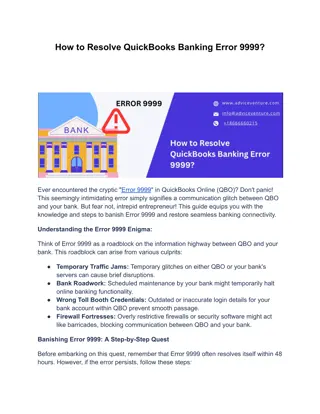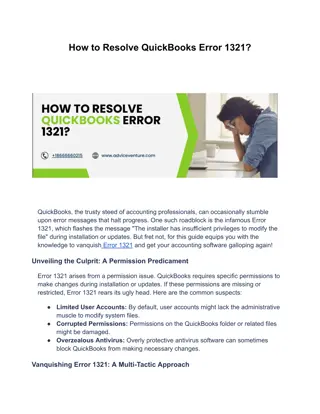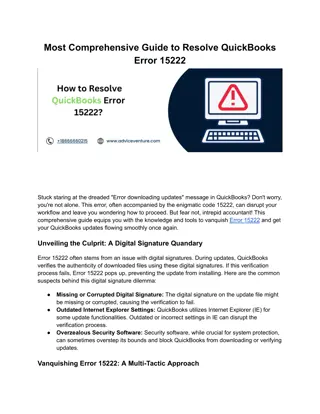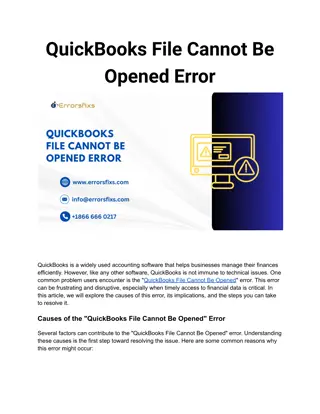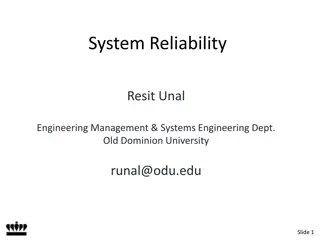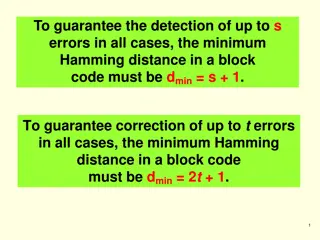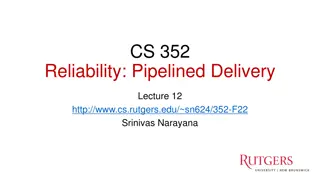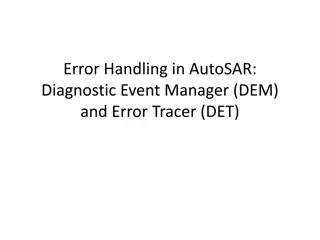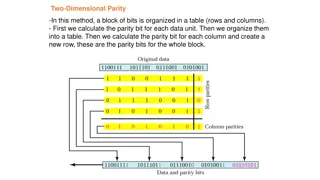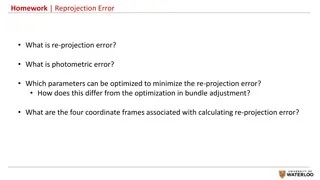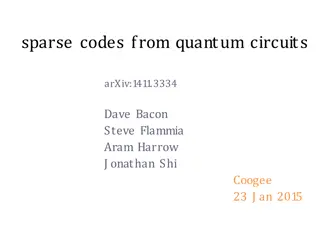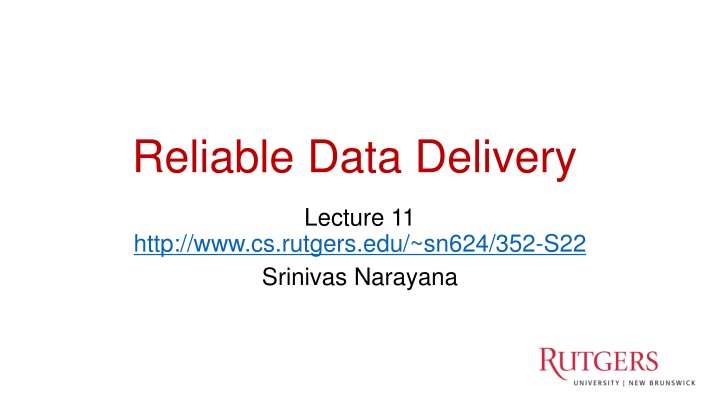
Error Detection in TCP and UDP Protocols
Explore the importance of error detection in transport layer protocols like TCP and UDP, including the key concepts, functions, and requirements for ensuring reliable data delivery. Learn how checksum functions work to detect errors in data transmission.
Download Presentation

Please find below an Image/Link to download the presentation.
The content on the website is provided AS IS for your information and personal use only. It may not be sold, licensed, or shared on other websites without obtaining consent from the author. If you encounter any issues during the download, it is possible that the publisher has removed the file from their server.
You are allowed to download the files provided on this website for personal or commercial use, subject to the condition that they are used lawfully. All files are the property of their respective owners.
The content on the website is provided AS IS for your information and personal use only. It may not be sold, licensed, or shared on other websites without obtaining consent from the author.
E N D
Presentation Transcript
Reliable Data Delivery Lecture 11 http://www.cs.rutgers.edu/~sn624/352-S22 Srinivas Narayana 1
Quick recap of concepts TCP established: (src IP, src port, dst IP, dst port) Port1 Port2 Interface1 TCP listening: (dst IP, dst port) Port3 Interface2 UDP: (dst IP, dst port) Src IP address Dst IP address Endpoint UDP: Abstraction to send & receive one- off packets. That s it. App src port # dst port # length chksum Packet at the network layer UDP segment structure
Error Detection in the Transport Layer
Why error detection? Network provides best effort service UDP is a simple and low overhead transport Data may be lost Data may be corrupted along the way (e.g., 1 -> 0) Data may be reordered However, simple error detection is possible! Was the data I received the same data the remote machine sent? Error detection is a useful feature for all transport protocols including TCP
Error Detection in UDP and TCP Key idea: have sender compute a function over the data Store the result in the packet Receiver can check the function s value in received packet An analogy: you re sending a package of goodies and want your recipient to know if goodies were leaked along the way Your idea: weigh the package; stamp the weight on the package Have the recipient weigh the package and cross-check the weight with the stamped value
Requirements on error detection function Function must be easy to compute Function must change (whp) if the packet changes If the packet was modified through these changes, the function value must change Function must be easy to verify UDP and TCP use a class of function called a checksum Very common idea: used in multiple parts of networks and computer systems
UDP & TCPs Checksum function Sender: treat segment contents as sequence of 16-bit integers checksum: addition (1 s complement sum) of segment contents sender puts checksum value into UDP/TCP checksum field Receiver: compute a checksum of the received segment, including the checksum in packet itself check if the resulting (computed) checksum is 0 NO an error is detected YES assume no error
Computing 1s complement sum Very similar to regular (unsigned) binary addition. However, when adding numbers, a carryout from the most significant bit needs to be added to the result Example: add two 16-bit integers 1 1 1 1 0 0 1 1 0 0 1 1 0 0 1 1 0 1 1 1 0 1 0 1 0 1 0 1 0 1 0 1 0 1 wraparound 1 1 0 1 1 1 0 1 1 1 0 1 1 1 0 1 1 sum 1 1 0 1 1 1 0 1 1 1 0 1 1 1 1 0 0 1 0 1 0 0 0 1 0 0 0 1 0 0 0 0 1 1 checksum 8
From the UDP specification (RFC 768) Checksum is the 16-bit one's complement of the one's complement sum of a pseudo header of information from the IP header, the UDP header, and the data, padded with zero octets at the end (if necessary) to make a multiple of two octets. The pseudo header conceptually prefixed to the UDP header contains the source address, the destination address, the protocol, and the UDP length. Warning: Technical language ahead
Some observations on checksums Checksums don t detect all bit errors Consider (x, y) vs. (x 1, y + 1) as adjacent 16-bit values in packet Analogy: you can t assume the package hasn t been meddled with if its weight matches the one on the stamp. More smarts needed for that. But it s a lightweight method that works well in many cases Checksums are part of the packet; they can get corrupted too The receiver will just declare an error if it finds an error However, checksums don t enable the receiver to detect where the error lies or correct the error(s) Checksum is an error detection mechanism; not a correction mechanism.
Some observations on checksums Checksums are insufficient for reliable data delivery If a packet is lost, so is its checksum UDP and TCP use the same checksum function TCP also uses the lightweight error detection capability However, TCP has more mature mechanisms for reliable data delivery (up next!)
Playing with checksums Let s craft some UDP packets (again)! sudo tcpdump -i lo udp XAvvv # observe packets sudo scapy # tool used to send crafted packets send(IP(dst="127.0.0.1")/UDP(sport=1024, dport=2048)/"hello world , iface="lo") Let s play with the checksums a bit!
Summary of UDP A simple transport: Send or receive a single packet from/to the correct application process. That s it Just a thin shim around network layer s best-effort delivery No connection building, no latency Suitable for one-off request/response messages Suitable for loss-tolerant but delay-sensitive applications No reliability, performance, or ordering guarantees Can do basic error detection (bit flips) using checksums Error detection is necessary to deliver data reliably, but it is insufficient
Packet loss Receiver Sender How might a sender and receiver ensure that data is delivered reliably (despite some packets being lost)? TCP uses three mechanisms
Coping with packet loss: (1) ACK Receiver Sender Key idea: Receiver returns an acknowledgment (ACK) per packet sent packet ACK If sender receives an ACK, it knows that the receiver got the packet. packet ACK
Coping with packet corruption: (1) ACK Receiver Sender ACKs also work to detect packet corruption on the way to the receiver One possibility: A receiver could send a negative acknowledgment, or a NAK, if it receives a corrupted packet Q: How to detect corrupted packet? One method: Checksum! packet NAK packet TCP only uses positive ACKs. ACK
Coping with packet loss: (2) RTO Receiver Sender What if a packet is dropped? Key idea: Wait for a duration of time (called retransmission timeout or RTO) before re-sending the packet RTO In TCP, the onus is on the sender to retransmit lost data when ACKs are not received Retransmission ACK Note that retransmission works also if ACKs are lost or delayed
How should the RTO be set? Receiver Sender A good RTO must predict the round-trip time (RTT) between the sender and receiver RTT: the time to send a single packet and receive a (corresponding) single ACK at the sender RTO Intuition: If an ACK hasn t returned, and our (best estimate of) RTT has elapsed, the packet was likely dropped. ACK RTT can be measured directly at the sender. No receiver involvement needed.
Coping with packet duplication Receiver Sender If ACKs delayed beyond the RTO, sender may retransmit the same data Receiver wouldn t know that it just received duplicate data from this retransmitted packet RTO Duplicate packet received! (Receiver doesn t know ) Add some identification to each packet to help distinguish between adjacent transmissions This is known as the sequence number ACK
Coping with packet loss: (3) Sequence #s Receiver Sender A bad scenario: Suppose an ACK was delayed beyond the RTO; sender ended up retransmitting the packet. 0 RTO At the receiver: sequence number helps disambiguate a fresh transmission from a retransmission Sequence number same as earlier: retransmission Fresh sequence number: fresh data 0 ACK
Coping with packet loss: (3) Sequence #s Receiver Sender A good scenario: packet successfully received and ACK returned within RTO SEQ 0 Receiver knows these are not duplicate, because sequence numbers are different RTO ACK Sequence numbers of successively transmitted packets are different SEQ 1 RTO
Coping with packet loss: (3) Sequence #s Receiver Sender A good scenario: packet successfully received and ACK returned within RTO SEQ 0 Receiver knows these are not duplicate, because sequence numbers are different RTO ACK ACK 0 Sequence numbers of successively transmitted packets are different SEQ 1 RTO ACK 1 Further, the receiver informs the sender which packet was ACK ed using an ACK sequence number
Q: What is the seq# of third packet? Receiver Sender Goal: Avoid ambiguity on which packet was received/ACK ed from both the sender and receiver s perspective SEQ 0 RTO ACK 0 One possibility: keep incrementing the seq #: 2, 3, SEQ 1 RTO ACK 1 Alternative: since seq # 0 was successfully ACK ed earlier, it is OK to reuse seq #0 for next transmission. Seq #s reused if enough time elapsed ???
Summary: Stop-and-Wait Reliability Sender sends a single packet, then waits for an ACK to know the packet was successfully received. Then the sender transmits the next packet. Receiver Sender SEQ 0 RTT ACK 0 If ACK is not received until a timeout (RTO), sender retransmits the packet SEQ 1 Disambiguate duplicate vs. fresh packets using sequence numbers that change on adjacent packets RTO Retransmit


